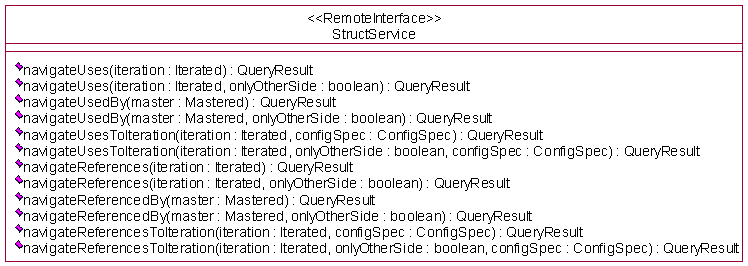See:
Description
| Interface Summary | |
| StructService | This service for the struct package contains "navigetters" to navigate
the IteratedUsageLink, IteratedReferenceLink and IteratedDescribeLink to both Mastered and Iterated
objects. |
| Class Summary | |
| AbstractStructLinkRIEHandler | Supported API: false Extendable: false |
| IteratedDescribeLink | A link specifying that an iteration provides descriptive information for a another iteration. |
| IteratedDescribeLinkRIEHandler | Returns a user friendly message when a ReferentialIntegrityException occurs when deleting an IteratedDescribeLink. |
| IteratedReferenceLink | A link specifying that an iteration (implementation) refers to another master. |
| IteratedReferenceLinkRIEHandler | Supported API: false Extendable: false |
| IteratedUsageLink | The IteratedUsageLink is an association between an iteration and a master. |
| IteratedUsageLinkRIEHandler | Supported API: false Extendable: false |
| StandardStructService | This implementation of StructService has adds several listeners
in StandardStructService.performStartupProcess() that deal primarily with copying links
and validating deletes. |
| StructHelper | This helper is for the StructService and accesses that service
via StructHelper.service. |
| StructServiceFwd | This service for the struct package contains "navigetters" to navigate
the IteratedUsageLink, IteratedReferenceLink and IteratedDescribeLink to both Mastered and Iterated
objects. |
Package wt.vc.struct Description
vc package - Version Structuring Service
The wt.vc.struct package
introduces an associative model for relating versions. Versioned data forms
links to other versioned data to further describe that data - parts associate
to other parts to form structures, indicating that a part is composed of or
built from other parts. Similarly, it is common for a document to refer to
other documentation. The struct package defines a "uses" and a
"references" concept to reflect these kinds of associations.
The following figure
illustrates the uses concept.

Link Representing the Uses
Concept
The uses concept is a
structuring concept indicating a tight coupling. An object that uses another
object identifies that object as essential to its implementation. For example,
a part built from other parts is not complete without these part; they are
required components. The struct package encapsulates the uses concept for use
by versioned data in the IteratedUsageLink.
The following figure
illustrates the references concept.

Link Representing the
References Concept
The references association
couples data more loosely than the uses association. For example, the
referenced data may be important to a document, but the document can be
disseminated without it. For example, a design specification that references
the requirements specification it was written for is still complete on its own.
The struct package's IteratedReferenceLink allows versioned data to participate
in references associations.
The wt.vc.struct package's
IteratedUsageLink and IteratedReferenceLink both link Iterated data (versions)
to Mastered data (masters). The fact that a master, not an iteration (or
version), is used or referenced by an implementation is an important aspect of
the links definition. They assume the versions for the master are
interchangeable and that changes that are not interchangeable result in a new
master (not a new, incompatible version). Note that the shared aggregation
modeled on the IteratedUsageLink shows its tighter coupling.
The following figure
illustrates the struct package APIs.

struct Package APIs
The struct package provides
navigate APIs for both the IteratedUsageLink and IteratedReferenceLink for
convenience and because of minor behavioral nuances. The navigateUses and
navigateReferences APIs behave exactly as would PersistenceManager's navigate,
however navigateUsedBy and navigateReferencedBy return only versions; they
filter out any iteration that is not the latest iteration. The
navigateUsesToIteration and navigateReferencesToIteration APIs navigate the
links to the masters, then resolve the masters to their appropriate versions
using the passed ConfigSpec. The masters for which there are no appropriate
versions are returned to indicate that the association exists but has no
qualifying representation given the ConfigSpec. The return value for the
navigate to iterations API, a QueryResult, consists of those versions (and
possibly masters) if onlyOtherSide is true. If it is false (that is, the links
are desired as well) a QueryResult containing Persistable's as elements is
returned. Each element is an array of length 2 with the link in the 0th
position and the version (or master) in the 1st position.
The IteratedUsageLink and
IteratedReferenceLink, while conceptually different, have the same internal
behavior. This following characteristics are shared by both associations:
- When an Iterated object is created from an
existing one (as a consequence of a check-out, new version, or new
branch), all IteratedUsageLinks and IteratedReferenceLinks to that
iteration are copied. This copy uses PersistenceManagerSvr's copyLink API,
which allows listeners of the COPY_LINK event to copy any links to the
IteratedUsageLink/IteratedReferenceLink that should be copied.
- To create, delete, or update IteratedUsageLinks
or IteratedReferenceLinks, the user must have permission to modify the
Iterated object.
- Creating these links between an iteration and
its own master is not allowed.
- A master can not be deleted if it has
IteratedUsageLinks or IteratedReferenceLinks to it.
The
customization, via extension, of the IteratedUsageLink and the
IteratedReferenceLink follows the same process as does any ObjectToObjectLink.
Note that the links are protected by the iterations; if the iteration is
frozen, so are these links. For this reason, it should not be necessary to
build a lot of business knowledge into the links; the business knowledge should
be put on the versions. Also note that struct's navigate APIs will navigate at
the abstract IteratedUsageLink/IteratedReferenceLink level. If extended and it
is desired to navigate only the new, concrete link, new APIs are required to
guarantee that only the new link is navigated.
|
|||||||||||
| PREV PACKAGE NEXT PACKAGE | FRAMES NO FRAMES | ||||||||||